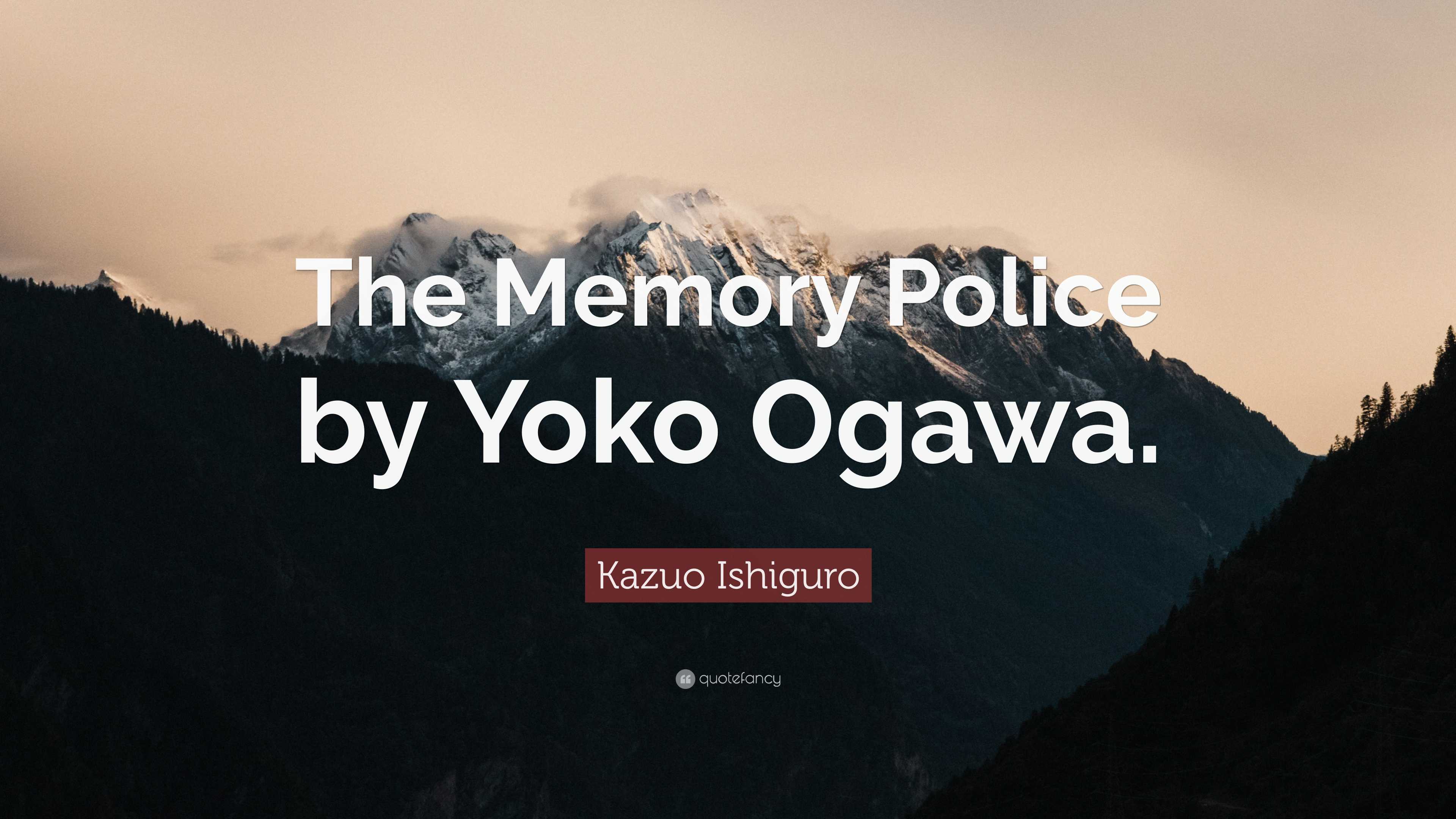Kazuo Ishiguro: Memory, Forgetting, And The Power Of Imagination

Table of Contents
Memory as a Fragile and Subjective Construct in Ishiguro's Novels
Ishiguro masterfully portrays memory not as a reliable record of the past, but as a subjective and often unreliable construct, shaped by individual perspective, desire, and self-preservation. His characters grapple with fragmented, distorted, and selectively remembered pasts, impacting their present lives and shaping their understanding of self.
- The Remains of the Day: Stevens, the aging butler, meticulously recounts his years of service, but his narrative reveals a systematic self-deception, a carefully curated memory that omits inconvenient truths about his past loyalties and missed opportunities. His selective memory functions as a coping mechanism, shielding him from the painful realities of his choices. This use of the unreliable narrator is a hallmark of Ishiguro's style.
- Never Let Me Go: Kathy, the narrator, grapples with fragmented memories of her childhood at Hailsham, a seemingly idyllic boarding school. These fragmented memories, combined with the gradually revealed truth about her and her friends' predetermined fates, contribute to a sense of profound loss and a questioning of identity. The impact of memory distortion on the clones' understanding of their lives is central to the novel.
- The Buried Giant: Axl and Beatrice's journey is shrouded in a fog of fading memories, reflecting the unreliable nature of historical accounts and the difficulty of reconstructing a truthful past, especially one steeped in violence and trauma. Their hazy recollections, interwoven with mythical elements, create a compelling narrative about the elusive nature of truth and the power of the past to shape the present.
Ishiguro employs various narrative techniques to highlight the fallibility of memory, including unreliable narrators, fragmented timelines, and the subtle manipulation of perspective, creating a compelling sense of ambiguity and inviting the reader to actively participate in the reconstruction of the past.
Forgetting as a Necessary Mechanism for Survival and Self-Preservation
In Ishiguro's novels, forgetting isn't simply the absence of memory, but rather a complex mechanism essential for survival and self-preservation. His characters often repress traumatic experiences or inconvenient truths to maintain a sense of order and sanity.
- The Remains of the Day: Stevens' meticulous adherence to his professional duties and his suppression of personal feelings serve as a form of self-imposed forgetting, preventing him from confronting the emotional cost of his unwavering loyalty. The repressed memories gradually surface, leading to a poignant self-reflection.
- Never Let Me Go: The clones' carefully constructed ignorance of their predetermined fates represents a form of societal forgetting—a deliberate suppression of uncomfortable truths to maintain a functional system. Their limited understanding of their own mortality shapes their experiences and relationships.
- The Buried Giant: The intentional forgetting of the past, particularly the brutal war between Saxons and Britons, plays a crucial role in shaping the present. The characters' struggle to remember highlights the ethical implications of forgetting and its effect on collective identity and social memory.
The ethical implications of forgetting, its impact on individual identity, and its role in shaping social narratives are central themes explored through Ishiguro’s skillful character development and plot construction. Forgetting, in Ishiguro's world, is not a passive process but a deliberate, often necessary, act of self-preservation.
The Power of Imagination and the Creation of Alternate Realities
Ishiguro's characters consistently use imagination as a powerful tool to construct alternative realities, find meaning in difficult circumstances, and cope with limitations. This imaginative capacity allows them to confront their pasts and envision potential futures, even in the face of despair.
- Never Let Me Go: Kathy's imaginative interpretation of her past and future—particularly her hope for deferral—shows the power of imagination as a coping mechanism in the face of impending mortality. Her capacity for empathy and her creation of narratives about her life offer a sense of hope and agency within a predetermined existence.
- The Remains of the Day: Stevens imagines a life lived differently, a life where he prioritized personal happiness over duty. This imagined alternative reality underscores the profound impact of his past choices and prompts a bittersweet reflection on his life's trajectory.
- The Buried Giant: The incorporation of mythical creatures and fantastical elements shapes the reality of the story, reflecting the blurring lines between historical fact and imaginative interpretation. These elements create a sense of mystery and allow Ishiguro to explore the ambiguous nature of memory and the resilience of the human spirit.
The role of fantasy and speculation in coping with existential limitations and creating hope are critical aspects of Ishiguro's exploration of the human condition. His novels frequently employ imaginative elements to transcend the limitations of reality, offering a space for hope, reconciliation, and meaning-making.
The Enduring Legacy of Kazuo Ishiguro: A Master of Memory, Forgetting, and Imagination
In conclusion, Kazuo Ishiguro's profound exploration of memory, forgetting, and imagination reveals the complexities of the human experience. His skillful use of narrative techniques, unreliable narrators, and compelling characters forces us to confront the fragility of memory, the ethical implications of forgetting, and the transformative power of imagination. Ishiguro's novels are not simply stories, but insightful meditations on the past, present, and the enduring capacity of the human spirit to find meaning in the face of uncertainty. Delve deeper into the fascinating world of Kazuo Ishiguro and explore the power of memory, forgetting, and imagination in his novels. Start with Never Let Me Go today!

Featured Posts
-
 Explorer Les Traditions Des Gens D Ici
May 25, 2025
Explorer Les Traditions Des Gens D Ici
May 25, 2025 -
 Ccmf 2025 Sold Out Demand Soars For Next Years Event
May 25, 2025
Ccmf 2025 Sold Out Demand Soars For Next Years Event
May 25, 2025 -
 Darwin Teen Arrested Shop Owner Stabbed During Nightcliff Robbery
May 25, 2025
Darwin Teen Arrested Shop Owner Stabbed During Nightcliff Robbery
May 25, 2025 -
 Young Hawaiian Artists Shine Sew A Lei Poster Contest For Memorial Day
May 25, 2025
Young Hawaiian Artists Shine Sew A Lei Poster Contest For Memorial Day
May 25, 2025 -
 Preparing For Flash Floods Essential Information On Flood Warnings And Alerts
May 25, 2025
Preparing For Flash Floods Essential Information On Flood Warnings And Alerts
May 25, 2025
Latest Posts
-
 Former Israeli Female Soldiers Demand Gaza Captive Release
May 26, 2025
Former Israeli Female Soldiers Demand Gaza Captive Release
May 26, 2025 -
 Yom Ha Zikaron 2024 Masa Israel Journeys Unprecedented English Ceremony
May 26, 2025
Yom Ha Zikaron 2024 Masa Israel Journeys Unprecedented English Ceremony
May 26, 2025 -
 Largest English Language Yom Ha Zikaron Ceremony Hosted By Masa Israel Journey
May 26, 2025
Largest English Language Yom Ha Zikaron Ceremony Hosted By Masa Israel Journey
May 26, 2025 -
 Ahtjajat Mtwaslt Fy Tl Abyb Llmtalbt Bewdt Alasra
May 26, 2025
Ahtjajat Mtwaslt Fy Tl Abyb Llmtalbt Bewdt Alasra
May 26, 2025 -
 Masa Israels Record Breaking English Yom Ha Zikaron Ceremony
May 26, 2025
Masa Israels Record Breaking English Yom Ha Zikaron Ceremony
May 26, 2025
